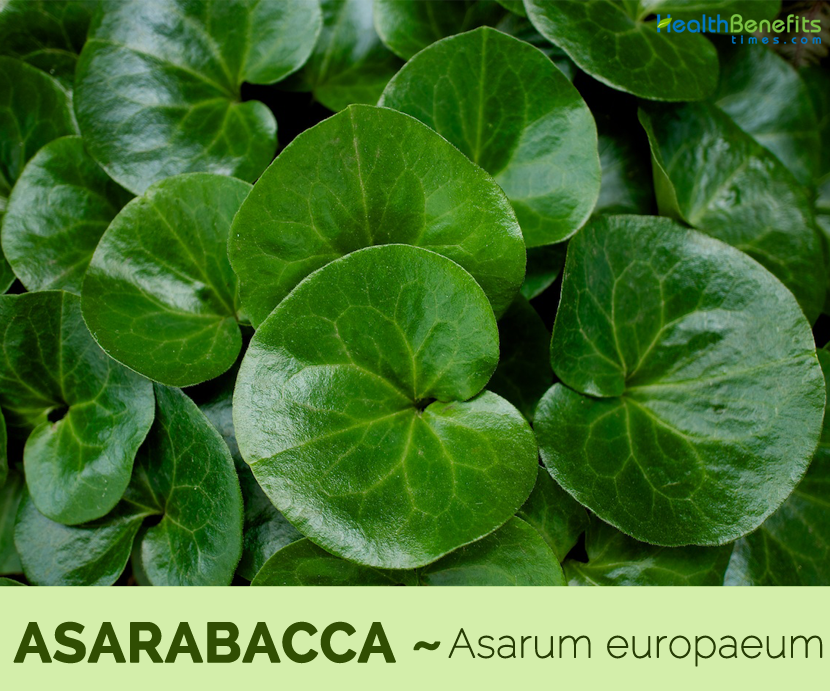| Asarabacca Quick Facts | |
|---|---|
| Name: | Asarabacca |
| Scientific Name: | Asarum europaeum |
| Origin | Central to southern Europe |
| Shapes | Many-seeded, indehiscent capsule divided into many chambers by false membranes. |
| Taste | Strong peppery taste |
Plant Descriptions
Asarabacca is a creeping, evergreen rhizomatous soft-wooded perennial plant that grows about 10-15 cm (4 to 6 inches) tall. The plant normally grows in open woodland and waterside thickets, especially in beech woodlands, river-bank, broad-leaved forests and stream valleys. It prefers humusy, slightly acidic, calcareous, consistently moist but well-drained soils. Roots are ash-colored, 2 or 3 lines in thickness, 4-angled, knotted, rough; has a pepper-like odor, a biting, spicy taste, and yields an ash-colored powder. It has thin, creeping rhizome that is branched and usually has 3 to 4 scale-like, brownish-green stipules.
Leaves
Leaves are dark green, shiny, kidney shaped and are petiolate and 5-10 cm wide. They are entire-margined, coriaceous, dark-green glossy above, pale and matte beneath, deeply reticulate and evergreen and they have a pepper-like taste and smell.
Flower
The plant produces bell shaped flowers. Flower tube is composed of fused sepals that end with 3 petal-like projections that are brownish towards their ends and dark purple toward the center. They are short peduncled, arising between the pair of leaves. Flowering normally takes place between May and June. Since the flowers are usually located under the leaves they are difficult to detect. After flowering the formation of a round and fleshy seed capsule follows.
Fruit
Fruits are many-seeded, indehiscent capsule divided into many chambers by false membranes. The fruit consists of several large, ovoid, and wrinkled, boat-shaped seeds with a spongy appendage. In former days, it was used in snuff and also medicinally as an emetic and cathartic. It is quite shade-tolerant and is often employed as a ground cover in gardens where little else will grow. It is occasionally collected for use as a spice or a flavoring. It has been used to ward off moths, as rat poison, textile dye, and in folk medicines.
Traditional uses and benefits of Asarabacca
- Root leaves and stems are cathartic, diaphoretic, emetic, errhine, sternutatory, stimulant and tonic.
- It is used in the treatment of affections of the brain, eyes, throat and mouth.
- When taken as a snuff, it produces a copious flow of mucous.
- Essential oil of the plant is the emetic and expectorant principle and is of value in the treatment of digestive tract lesions, silicosis, dry pharyngeal and laryngeal catarrh etc.
- Dried and powdered leaves of this plant are used in the sneezing and giving relief to headache, weak eyes and treatment for rhinitis, pneumonia, angina pectoris, migraine, liver diseases and jaundice.
- Mixed with Ribwort, this herb is used to remove mucous from the respiratory passages.
- It will induce menstruation and abortion.
- It was also used as a remedy for dehydration.
- It is used to treat bronchitis, laryngitis, asthma, silicosis, and cough related to smoking.
- Asari root and Asari root with herb are used for similar indications in folk medicine.
Other facts
- The toxin is neutralized by drying.
- A vibrant apple-green dye is obtained from plant.
- A useful ground cover for a shady position so long as it is not dry, spreading by its roots.
- These shade-tolerant plants are used as a ground cover in gardens.
- The plant is dangerous and has been banned for medical application in several countries.
- Asarum europaeum has been used to ward off moths, as rat poison, textile dye, and in folk medicine.
Daily Dosage
The average daily oral dose of the dry extract for adults and children aged 13 and over is 30 mg, which corresponds to 30 mg phenylpropane derivatives and should be spread over 2 to 3 doses per day. Children aged 2 and over can take an extract corresponding to 5 mg phenylpropanol derivatives 3 times daily. The average single dose of the drug is 0.1 gm.
Homeopathic Dosage
5 to 10 drops, 1 tablet, 5 to 10 globules 1 to 3 times daily or 1 ml injection solution twice weekly sc; ointments 1 to 2 times daily; Dl and D2 should not be taken for longer than 1 month (HAB1).
Storage
Coated tablets and pills that contain the purified dry extract or the tincture from the rhizome can be stored for a period of 28 days in conditions of high temperature, humidity and light. Under preferred storage conditions (i.e. brown glass, away from light), they can be stored for up to 2 years, after which period stability should be checked.
Precautions
- The plant is poisonous in large doses.
- If the plant is consumed it can cause burning in the mouth, heartburn, vomiting, severe abdominal pain, diarrhea, and kidney inflammation.
- It can cause bleeding in the uterus and may have an abortifacient effect. It should never be used by pregnant or nursing women.
- Essential oil is highly toxic and can cause kidney damage and respiratory system failure.
- It is corrosive to the mucous membranes and can irritant the skin and can cause blistering.
- Handling this plant with bare hands may cause skin irritation.
References:
http://www.plantnames.unimelb.edu.au/Sorting/Asarum.html
http://davesgarden.com/guides/pf/go/1467/
http://www.pfaf.org/user/plant.aspx?latinname=Asarum+europaeum
http://www.cabi.org/isc/datasheet/112466
http://www.botanical.com/botanical/mgmh/a/asara071.html
http://practicalplants.org/wiki/Asarum_europaeum
https://en.wikipedia.org/wiki/Asarum_europaeum
https://plants.usda.gov/plantguide/pdf/cs_asca.pdf
http://www.herbs2000.com/herbs/herbs_asarum.htm
http://www.theplantlist.org/tpl1.1/record/kew-2654312
https://plants.usda.gov/core/profile?symbol=ASARU
http://www.plantlives.com/docs/A/Asarum_europaeum.pdf
Comments
comments
